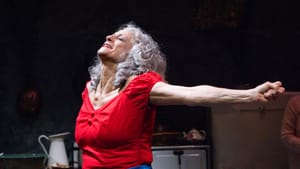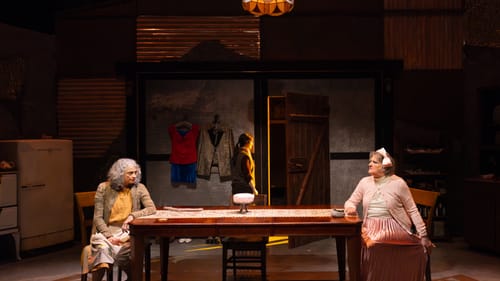Stay in the Loop
BSR publishes on a weekly schedule, with an email newsletter every Wednesday and Thursday morning. There’s no paywall, and subscribing is always free.
A haunting nightly dance
Hedgerow Theatre Company Presents Enda Walsh’s The New Electric Ballroom

Hedgerow Theatre Company’s feverish production of The New Electric Ballroom considers what happens when we allow yesterday’s fantasies to kindle a present-day nightmare. Enda Walsh’s 2009 play fittingly defines itself as a mixture of “torture and foreplay.” On the surface, this play involves three sisters of varying ages who find themselves proverbially trapped in a small town off the western coast of Ireland. However, as Walsh’s play reveals more sinister, psycho-sexual undertones, we begin to understand these women are immobilized by an urge far more difficult to define.
Walsh’s idiosyncratic and vaguely non-realistic writing style quickly becomes obvious as the women speak to but rarely emotionally engage with one another. At times poetic, at times abstract, and at times infuriating, his prose borrows from the traditions of black humor and mild absurdism popularized by the likes of Samuel Beckett and occasionally present in the work of contemporary Irish dramatists such as Martin McDonagh or Conor McPherson. To his credit, Walsh bucks a long-standing absurdist tradition of denying existential storylines to women characters, and for that reason, the play deserves to be staged.
Three ascetic sisters
This production opens with a scintillating prelude thanks to Lily Fossner’s lighting design. Cast-iron lamps hypnotically flicker the stage from ethereal darkness into a dreary cottage interior. Here, the audience meets the ascetic sisters residing aimlessly and almost compulsively within these four walls: Breda (Janis Dardaris), Clara (Marcia Saunders), and Ada (Hedgerow artistic director Marcie Bramucci).
While the dialogue is provocative and bizarre, the narrative thread is relatively easy to follow. The sisters face a crisis of unhappiness. Each night, the now-aged Breda and Clara dress in youthful attire of the 1950s and reenact what is presumably their first sexual encounter when they traveled outside their small-town home to experience nightlife and romance at a nostalgic sock hop they call the "new electric ballroom." The heartaches, mistrust, and fear of abandonment that ensued are recalled onstage.
Resurrecting the ballroom
Fossner’s lights, Marie Laster’s set, and Georgia Evans’s costumes fantastically hearken to this ballroom, which is always summoned with an element of the grotesque: a clownish smudge of lipstick, a dimming spotlight, a blank expression when describing moments of ecstasy. This defense mechanism proves more and more futile as the play progresses, feeding into each woman’s ongoing detachment and distress. The cyclical nature of these evenings alludes to ongoing impacts of gender-based trauma, abandonment, and sexual repression. The most haunting element, however, is the fact that these characters reenact this sequence of events every night without fail.

Emma Gibson directs the piece with gusto and grace but is nevertheless frequently unable to tap into the abstract nature of Walsh’s script with a clear sense of ease. Thanks to strong performances by Saunders and Dardaris, this production turns smoothly between humor and pain. Saunders is particularly evocative as Clara, a woman who carries her adolescent naivety with her into adulthood. At the same time, Dardaris’s Breda is fueled by angst and cynicism. Stephen Patrick Smith rounds out the cast as the intrusive neighbor, Patsy. Patsy is a generous but emotionally distant fisherman and possible suitor to Ada. However, he stands in the perpetual shadow of the "new electric ballroom."
A multi-generational challenge
The contrast between adolescence and aging is perhaps the most poignant message of the play as it reveals a multi-generational challenge for these women to establish self-worth, agency, and protection that exists separately from male attention. However, like the plight of the three women characters, where the play strives for excitement, it ultimately feels stuck within the banal.
Hedgerow Theatre’s production of The New Electric Ballroom is nevertheless both chilling and challenging. It is an absurdist mystery that asks us to look within ourselves for clues. I hope that as Breda, Clara, and Ada attempt to reinvent their own pasts, audiences too will cling to the hope of a better future.
What, When, Where
The New Electric Ballroom. By Enda Walsh, directed by Emma Gibson. $20-$35. Through March 3, 2024, at Hedgerow Theatre Company, 64 Rose Valley Road, Media. (610) 565-4211 or hedgerowtheatre.org.
Accessibility
Hedgerow is a wheelchair-accessible venue. Call the box office or email [email protected] with specific seating needs. There will be open-captioned performances of The New Electric Ballroom on Saturday, February 24, at 7:30pm; Sunday, February 25, at 2pm; Thursday, February 29, at 7:30pm; and Friday, March 1, at 7:30pm. There will be a relaxed and audio-described performance on Sunday, February 25, at 2pm.
Sign up for our newsletter
All of the week's new articles, all in one place. Sign up for the free weekly BSR newsletters, and don't miss a conversation.

 Melissa Lin Sturges
Melissa Lin Sturges